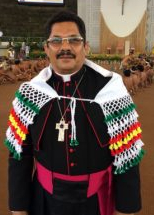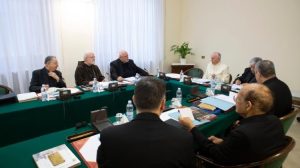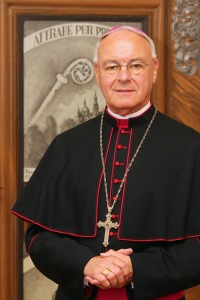 The Holy See today released the full list of participants of the Special Assembly of the Synod of Bishops for the Pan-Amazon region, to take place from 6 to 27 October in Rome. The assembly, which has been the subject of much discussion, hopes and fears over the past months, will discuss the problems faced by the Church in the Amazon region and try to find specific solutions with an eye on both the availability of the sacraments to the faithful there and the threats faced by people and environment in that area. Solutions which the synod assembly may arrive at could, some fear, then be applied globally. The topic of mandatory celibacy for priests has received special attention, as more than a few have suggested that the Synod could allow married men to be ordained to the priesthood so as to relieve that shortage of priests in the Amazon region. The theological and ecclesiastical repercussions, some fear, could have global consequences.
The Holy See today released the full list of participants of the Special Assembly of the Synod of Bishops for the Pan-Amazon region, to take place from 6 to 27 October in Rome. The assembly, which has been the subject of much discussion, hopes and fears over the past months, will discuss the problems faced by the Church in the Amazon region and try to find specific solutions with an eye on both the availability of the sacraments to the faithful there and the threats faced by people and environment in that area. Solutions which the synod assembly may arrive at could, some fear, then be applied globally. The topic of mandatory celibacy for priests has received special attention, as more than a few have suggested that the Synod could allow married men to be ordained to the priesthood so as to relieve that shortage of priests in the Amazon region. The theological and ecclesiastical repercussions, some fear, could have global consequences.
Apart from the usual suspects, such as the heads of the dicasteries of the curia and religious elected by the Union of Superior Generals, the majority of participants are bishops and priests from the Amazon region. Countries represented are Guyana*, Suriname*, French Guiana*, Bolivia, Brazil, Colombia, Ecuador, Peru and Venezuela.
As ever, there will also be a number of ‘fraternal delegates’ representing other Christian church communities. In this case, the Presbyterian, Evangelical, Anglican and Lutheran churches and the Assembly of God. Other special invitations were issued to a number of lay experts including former secretary general of the United Nations, Ban Ki-moon.

Pope Francis has also selected a number of personal appointments. These include a number of cardinals who have long been considered his closest collaborators, such as Cardinals Maradiaga, Gracias and Marx. He has also added three prelates who will be made cardinals on October 4th, just days before the assembly opens: Archbishops Ambongo Besungu of Kinshasa and Hollerich of Luxembourg (at left), and Fr. Czerny of the Dicastery for Promoting Integral Human Development, who also serves as one of the two special secretaries of the Synod assembly.
 Also of note is the role of Bishop Karel Choennie of Paramaribo (at right). As his diocese, which covers all of Suriname, is included in the pan-Amazon region, he is an automatic participant, but he has also served on the Presynodal Council, which was tasked with the preparations for the upcoming assembly. Another member of this body is Bishop Erwin Kräutler, the Austrian-born bishop-prelate emeritus of Xingu in Brazil. The 80-year-old prelate presents himself as a close confidant of Pope Francis, but he also supports a number of problematic changes to Catholic teaching and practice.
Also of note is the role of Bishop Karel Choennie of Paramaribo (at right). As his diocese, which covers all of Suriname, is included in the pan-Amazon region, he is an automatic participant, but he has also served on the Presynodal Council, which was tasked with the preparations for the upcoming assembly. Another member of this body is Bishop Erwin Kräutler, the Austrian-born bishop-prelate emeritus of Xingu in Brazil. The 80-year-old prelate presents himself as a close confidant of Pope Francis, but he also supports a number of problematic changes to Catholic teaching and practice.
Lastly, while the list of participants makes clear that this special assembly is very much localised – devoted to a specific area, led by people from that area – there are some connections to the wider world. In the first place to Rome of course, with the curia involved as they are in every Synod assembly. Other continents are also represented however. Among the pontifical appointments, Europe stands out, mostly because of the presence of Italian prelates. And these are not only members of the curia, but also ordinaries of Italian dioceses. Among the special invitees, Germany is also quite present. While only Cardinal Marx was invited by the pope, the heads of Adveniat (the German Church’s aid organisation for the Church in Latin America) and Misereor (the German bishops’ development organisation) will also participate. Asia is rather absent, but Africa is not. The presence of two participants from the Democratic Republic of the Congo, as well as, from Oceania, Cardinal Ribat from Papua New Guinea, makes sense, as these countries both include large stretches of pristine rain forest and a significant number of Catholic faithful who can not always be reached easily. The same problems are also faced in the Amazon. North America, then, is represented by a Canadian and four Americans, including Bishop Robert McElroy of San Diego, a like mind to Pope Francis.
* As the bishops of these countries are members of the bishops’ conference of the Antilles, the president of that body, Bishop Gabriel Malzaire of Roseau, Dominica, also participates.





 In their spring assembly, which this year took place in the Emsland town of Lingen, in the Diocese of Osnabrück, the German bishops discussed, among other things, several hot topics. First and foremost the abuse crisis, of course, on which they heard from various experts and were told that the Church is losing (or even already has lost) all her credibility as a result of the sexual abuse committed by clergy and the subsequent coverup by bishops and superiors.
In their spring assembly, which this year took place in the Emsland town of Lingen, in the Diocese of Osnabrück, the German bishops discussed, among other things, several hot topics. First and foremost the abuse crisis, of course, on which they heard from various experts and were told that the Church is losing (or even already has lost) all her credibility as a result of the sexual abuse committed by clergy and the subsequent coverup by bishops and superiors. In the post-meeting press conference (text
In the post-meeting press conference (text  30 January: Alberto Cardinal Suárez Inda, archbishop emeritus of Morelia, Mexico
30 January: Alberto Cardinal Suárez Inda, archbishop emeritus of Morelia, Mexico In Belgium, Bishop Luc Van Looy of Ghent (pictured at left) has already had his retirement accepted. At 77, he completed a two-year extension to his mandate last year. He is to remain in office until the appointment and installation of his successor. Namur’s Bishop Remy Vancottem is, at 75, also past retirement age, so the southeastern diocese may see a new bishop before the year is out as well.
In Belgium, Bishop Luc Van Looy of Ghent (pictured at left) has already had his retirement accepted. At 77, he completed a two-year extension to his mandate last year. He is to remain in office until the appointment and installation of his successor. Namur’s Bishop Remy Vancottem is, at 75, also past retirement age, so the southeastern diocese may see a new bishop before the year is out as well. In October, the Synod of Bishops will gather again for a special assembly for the Pan-Amazonian region, to discuss the specific challenges for the Church there. The expectations are high, as many assume to what will be decided there, especially on the topic of married priests, will have global consequences. Participation in the special assembly is limited to bishops from the area, which means there is a minute Dutch link, at least when it comes to language, in the person of the bishop of Paramaribo, Msgr. Karel Choennie. Bishop Choennie is a member of the pre-synodal council preparing the special assembly in cooperation with Synod of Bishops’ general secretariat.
In October, the Synod of Bishops will gather again for a special assembly for the Pan-Amazonian region, to discuss the specific challenges for the Church there. The expectations are high, as many assume to what will be decided there, especially on the topic of married priests, will have global consequences. Participation in the special assembly is limited to bishops from the area, which means there is a minute Dutch link, at least when it comes to language, in the person of the bishop of Paramaribo, Msgr. Karel Choennie. Bishop Choennie is a member of the pre-synodal council preparing the special assembly in cooperation with Synod of Bishops’ general secretariat. The decision was not unexpected, but it may have important repercussions for the future work of the Council of Cardinals as well as for Pope Francis’ efforts to reform the Curia. In September, the nine-member Council had requested the pope to reflect on “the work, structure and composition of the Council itself, also taking into account the advanced age of some members”, as today’s
The decision was not unexpected, but it may have important repercussions for the future work of the Council of Cardinals as well as for Pope Francis’ efforts to reform the Curia. In September, the nine-member Council had requested the pope to reflect on “the work, structure and composition of the Council itself, also taking into account the advanced age of some members”, as today’s  The three cardinals are all of advanced age, with Cardinal Pell being the youngest at 77. In fact, only for Cardinal Monsengwo Pasinya would age have been the sole reason to be let go from the Council. In February, the 79-year-old Congolese prelate had a coadjutor archbishop appointed to assist him in his Archdiocese of Kinshasa. In November this coadjutor, Archbishop Fridolin Ambongo Besungu, took over as archbishop of Kinshasa and Cardinal Monsengwo Pasinya retired. The letting go of Cardinals Pell and Errázuriz ,, although in part motivated by their age, is also coloured by their involvement in sexual abuse cases, with Cardinal Errázuriz playing a role in the abuse crisis in Chile and Cardinal Pell currently on trial in his native Australia.
The three cardinals are all of advanced age, with Cardinal Pell being the youngest at 77. In fact, only for Cardinal Monsengwo Pasinya would age have been the sole reason to be let go from the Council. In February, the 79-year-old Congolese prelate had a coadjutor archbishop appointed to assist him in his Archdiocese of Kinshasa. In November this coadjutor, Archbishop Fridolin Ambongo Besungu, took over as archbishop of Kinshasa and Cardinal Monsengwo Pasinya retired. The letting go of Cardinals Pell and Errázuriz ,, although in part motivated by their age, is also coloured by their involvement in sexual abuse cases, with Cardinal Errázuriz playing a role in the abuse crisis in Chile and Cardinal Pell currently on trial in his native Australia. In February of next year, Pope Francis will receive the presidents of the world’s bishops’ conferences to discuss the “protection of minors”, as today’s press communique
In February of next year, Pope Francis will receive the presidents of the world’s bishops’ conferences to discuss the “protection of minors”, as today’s press communique  While Pope Francis is free to appoint other delegates to the assembly, and he would be wise to do so, the presidents of the bishops’ conferences are expressly invited, or, if you will, summoned. There are 114 Roman-rite conferences in the Church, and a further 21 of Eastern rites. The presidents of these are elected by the members of each conference, and they need not be a cardinal or archbishop (metropolitan or not). The president of the Dutch Bishops’ Conference is the bishop of Rotterdam, Msgr. Hans van den Hende (pictured), while the Belgian bishops, on the other hand, are headed by Cardinal Jozef De Kesel, and the Germans by Cardinal Reinhard Marx. The Nordic Bishops’ Conference then, made up of bishops from five countries, have the bishop of Copenhagen, Msgr. Czeslaw Kozon, as their president. It is unknown if bishops from dioceses which do not belong to a conference, such as Luxembourg, will be invited as well.
While Pope Francis is free to appoint other delegates to the assembly, and he would be wise to do so, the presidents of the bishops’ conferences are expressly invited, or, if you will, summoned. There are 114 Roman-rite conferences in the Church, and a further 21 of Eastern rites. The presidents of these are elected by the members of each conference, and they need not be a cardinal or archbishop (metropolitan or not). The president of the Dutch Bishops’ Conference is the bishop of Rotterdam, Msgr. Hans van den Hende (pictured), while the Belgian bishops, on the other hand, are headed by Cardinal Jozef De Kesel, and the Germans by Cardinal Reinhard Marx. The Nordic Bishops’ Conference then, made up of bishops from five countries, have the bishop of Copenhagen, Msgr. Czeslaw Kozon, as their president. It is unknown if bishops from dioceses which do not belong to a conference, such as Luxembourg, will be invited as well.
 On the same 5th of June it was announced this had been the last such day presided over by Bishop Heinz Joshistef Algermissen. That was not unexpected, as the bishop reached the age of 75 in February, and there was no reason to assume that his retirement would not be accepted within the following months. Bishop Algermissen led the Diocese of Fulda since 2001. Before that he served as an auxiliary bishop of Paderborn for five years.
On the same 5th of June it was announced this had been the last such day presided over by Bishop Heinz Joshistef Algermissen. That was not unexpected, as the bishop reached the age of 75 in February, and there was no reason to assume that his retirement would not be accepted within the following months. Bishop Algermissen led the Diocese of Fulda since 2001. Before that he served as an auxiliary bishop of Paderborn for five years. Today, the Diocese of Fulda covers the northerns and eastern parts of the Land of Hesse, a small part of Thuringia and and exclave in Bavaria. Within its 10,318 square kilometres live some 400,000 Catholics a little of 20% of the entire population. It remains a pilgrimage site because of St. Boniface’s wish to be buried there, instead of in Mainz or Utrecht. He had been killed in the Frisian swamps near what is now Dokkum in the Netherlands (hence the connection to the the Diocese of Groningen-Leeuwarden, hinted at above). With the acceptance of the retirement of Bishop Algermissen, and until the catedral chapter has chosen a diocesan administrator, Bishop Karlheinz Diez leads the diocese. He is Fulda’s sole auxiliary, making him the automatic choice for the role.
Today, the Diocese of Fulda covers the northerns and eastern parts of the Land of Hesse, a small part of Thuringia and and exclave in Bavaria. Within its 10,318 square kilometres live some 400,000 Catholics a little of 20% of the entire population. It remains a pilgrimage site because of St. Boniface’s wish to be buried there, instead of in Mainz or Utrecht. He had been killed in the Frisian swamps near what is now Dokkum in the Netherlands (hence the connection to the the Diocese of Groningen-Leeuwarden, hinted at above). With the acceptance of the retirement of Bishop Algermissen, and until the catedral chapter has chosen a diocesan administrator, Bishop Karlheinz Diez leads the diocese. He is Fulda’s sole auxiliary, making him the automatic choice for the role.
